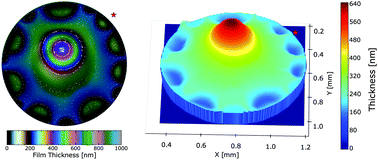Dynamic fluid-film interferometry as a predictor of bulk foam properties†
Abstract
Understanding and enabling the control of the properties of foams is important for a variety of commercial processes and consumer products. In these systems, the role of surface active compounds has been the subject of many investigations using a wide range of techniques. The study of their influence on simplified geometries such as two bubbles in a liquid or a thin film of solution (such as in the well-known Scheludko cell), has yielded important fundamental understanding. Similarly, in this work an interferometric technique is used to study the dynamic evolution of the film formed by a single bubble being pressed against a planar air–liquid interface. Here interferometry is used to dynamically measure the total volume of liquid contained within the thin-film region between the bubble and the planar interface. Three different small-molecule, surfactant solutions were investigated and the data obtained via interferometry were compared to measurements of the density of bulk foams of the same solutions. The density measurements were collected with a simple, but novel technique using a conical-shaped bubbling apparatus. The results reveal a strong correlation between the measurements on single bubbles and complete foams. This suggests that further investigations using interferometric techniques can be instrumental to building a more detailed mechanistic understanding of how different surface-active compounds influence foam properties. The results also reveal that the commonly used assumption that surfactant-laden interfaces may be modeled as immobile, is too simplistic to accurately model interfaces with small-molecule surfactants.


 Please wait while we load your content...
Please wait while we load your content...